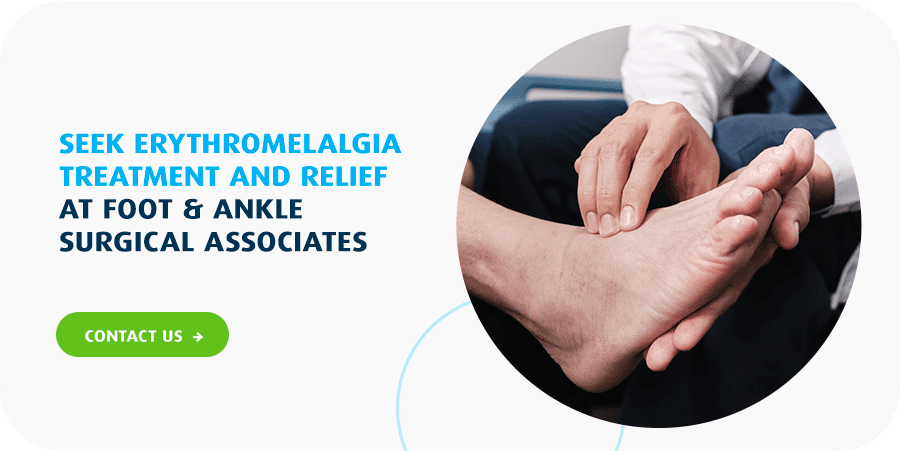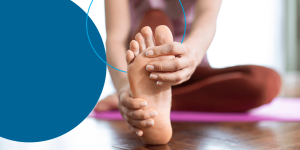
Erythromelalgia, also known as Mitchell’s disease, is a rare neurovascular condition affecting the extremities, most commonly the feet. It can also occur in your hands, face and other body parts.
Those living with this illness experience discomfort and often limit their activities to avoid flare-ups. This guide is here to help you understand the condition, its symptoms, available treatments and tips for managing erythromelalgia.
Understanding Erythromelalgia
An intense, burning sensation in the feet is erythromelalgia’s leading characteristic. Extreme redness of the skin and increased skin temperatures in affected areas are other typical symptoms. The term “erythromelalgia” is a combination of three Latin words — “erythro,” meaning “redness,” “mel,” which means “limb,” and “algia,” which means “pain.”
Erythromelalgia is usually a bilateral condition, affecting both sides of the body. However, it sometimes occurs unilaterally. The disease can vary significantly from person to person — for example, sweating more or less in the affected body part. For most people, the symptoms are intermittent. Those living with erythromelalgia experience erratic episodes of painful, red-hot extremities. These symptoms can appear gradually, and sometimes the disease remains mild for years.
Erythromelalgia can also have a sudden onset, with symptoms becoming severe in a matter of weeks or months. This disease is quite unpredictable due to the different ways it affects those who have it.
Doctors have not pinpointed a single trigger of erythromelalgia. The leading hypothesis is that this condition results from dysfunctions in the constriction and widening of the diameter of specific blood vessels, leading to abnormal blood flow to the extremities. The disease can be an isolated primary condition or a secondary condition caused by various other underlying disorders.

Primary erythromelalgia does not result from an underlying disease. There are two types.
- Inherited erythromelalgia: Sometimes, this condition runs in families or occurs due to genetic mutations. The mutations, which can affect pain signals, can be hereditary.
- Idiopathic erythromelalgia: Idiopathic erythromelalgia is when the disease appears for unknown reasons, which is the most common way for it to manifest.
Secondary erythromelalgia stems from an underlying neurological, blood or immunological condition, such as autoimmune diseases and neuropathy.
Look for the following erythromelalgia symptoms:
- Swelling
- Burning pain that typically starts as itching
- Sweating too much or too little
- Warm or hot skin
- Redness, the shade of which can vary depending on skin tone
Diagnosis, Treatment and Relief Options
Since erythromelalgia occurs so infrequently, you should know how to get diagnosed and find reliable erythromelalgia relief tactics.
Diagnosing Erythromelalgia
Health professionals use several methods to diagnose erythromelalgia. Because the disease is so rare and tends to affect people differently, it usually requires a battery of tests and screening tools like blood labs, X-rays, genetic testing and imaging studies to arrive at an erythromelalgia diagnosis. Your doctor may also use thermography, which requires a specialized camera to pinpoint differences in your skin’s temperature.
Erythromelalgia Treatment
You might instinctively soothe what causes burning feet with an ice bath. However, this will worsen your symptoms and increase your risk of challenging skin complications.
Effective remedies depend on what caused your erythromelalgia. Secondary erythromelalgia treatments target the underlying issue to relieve your symptoms. Treating primary erythromelalgia requires medication.
Various oral drugs have proven effective at relieving primary erythromelalgia symptoms, including:
- Antidepressants
- Anticonvulsants
- Prescription painkillers
- Blood pressure medicine
Other methods include:
- Lidocaine infusions, which are numbing medications you receive intravenously
- Pain management therapies
- Topical medications, like creams and ointments, applied to the skin
- Nutritional supplements
Erythromelalgia Relief
Several non-medical therapies can relieve erythromelalgia pain, redness, swelling and other symptoms:
- Point a fan at the affected areas.
- Wrap cold first-aid gel packs in a towel and apply them to your skin in 15-minute intervals.
- Rest on a cool surface, like a tiled floor.
- If you experience erythromelalgia in your feet, elevate them.
Living With Erythromelalgia
An erythromelalgia flare can feel like blades cutting your skin, severe sunburn, tightness or a scald from hot water. If you live with erythromelalgia, try these tips to stay comfortable and avoid triggering your symptoms.
- Rigorous exercise: When exercising, choose gentle activities that don’t excessively elevate your body temperature. Yoga, swimming and tai chi are good examples of erythromelalgia-friendly exercises.
- Stay in cooler environments: Try your best to avoid the heat and prioritize your outdoor activities during the mornings when the temperature is lower.
- Avoid trigger foods and beverages: Caffeine, spicy foods and other meals that can raise your body temperature can trigger erythromelalgia.
- Prepare sleeping conditions: Before going to bed, prep your sleeping area. Decrease the overnight temperature with fans or air conditioning, and use lightweight bedding made from a material like bamboo, linen or eucalyptus.
- Take lukewarm showers: Showering is better than bathing because it doesn’t submerge your body in hot water. It is easier to keep your body cool in lukewarm water when showering.
Seek Erythromelalgia Treatment and Relief at Foot & Ankle Surgical Associates
At Foot & Ankle Surgical Associates, our doctors work with you to create a plan and stick to a routine to help you live comfortably with your erythromelalgia. We will recommend effective treatments and relieving methods that fit your lifestyle and manage your symptoms. From a wealth of podiatry, wellness and education services, we offer the best and most comprehensive treatments for all foot-related conditions. Contact us today to learn more about what we offer and make an appointment.




